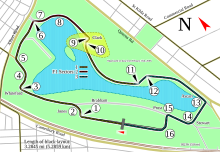1996 Australian Grand Prix
| Race details | |||
|---|---|---|---|
| Race 1 of 16 in the 1996 Formula One season | |||
 |
|||
| Date | 10 March 1996 | ||
| Location | Melbourne Grand Prix Circuit, Melbourne, Australia | ||
| Course | Temporary street circuit | ||
| Course length | 5.302 km (3.295 mi) | ||
| Distance | 58 laps, 307.516 km (191.110 mi) | ||
| Weather | Dry with temperatures reaching up to 23 °C (73 °F) | ||
| Pole position | |||
| Driver | Williams-Renault | ||
| Time | 1:32.371 | ||
| Fastest lap | |||
| Driver |
|
Williams-Renault | |
| Time | 1:33.421 on lap 27 | ||
| Podium | |||
| First | Williams-Renault | ||
| Second | Williams-Renault | ||
| Third | Ferrari | ||
The 1996 Australian Grand Prix was a Formula One motor race held on 10 March 1996 at Melbourne. It was the first time this race was held in Melbourne since 1984, taking over from Adelaide as the host of the Australian Grand Prix. It was the first time the Australian World Championship round had been held at the site of a previous Australian Grand Prix venue, albeit on a vastly different circuit, with the surrounds of the Albert Park Lake having played host to the Australian Grand Prix in 1953 and 1956. This was the debut race of the future world champion Jacques Villeneuve.
This was second grand prix in a row held in Australia, the previous race being the conclusion to the 1995 season.
Taki Inoue was scheduled to race for the Minardi team as a pay driver but when no money materialised prior to the race he was replaced by Fisichella. Marlboro had expressed interest in Fisichella running early on.
The race was the first to use the new race-start system, still used in Formula 1 today, replacing the old red to green light system. Under the new system, five red lights would come on at one second intervals, starting after the last driver reached his grid box. There would then be a pre-determined pause, and then the five lights would go off simultaneously. This system was partially designed to try to eliminate some of the problems caused by drivers stalling on the grid, which in the past, had often led to start line crashes.
This was also the first race to have a single qualifying session on Saturday afternoon; the Friday session had been dropped for 1996.
Jacques Villeneuve, making his début in Formula One, took pole position.
Both Fortis did not make the race due to the new 107% rule for qualifying, which said any car that qualified 107% slower than the pole time (1:38.837 in this race) would be excluded. Incidentally, the team had logged its best result of 7th one race ago at the season-ending 1995 Australian Grand Prix
...
Wikipedia
